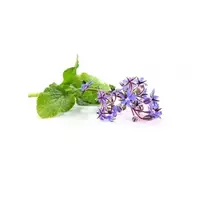Borago cucumber grass (borage)

Borago cucumber grass or borage is a flowering plant in the Burachnikov family. The family is represented by just one genus of the Burachnik medicinal plant or Borago officinalis. This annual herbal plant grows in Asia, Europe, as well as Africa and America. Burachnik chooses fairly specific places of growth, so the plant has long been considered a weed. Borago cucumber grass (borage) is a plant that rarely exceeds 100 cm in height.
The chemical composition of borago is enriched with a large number of useful compounds of natural origin, therefore this product is considered useful and dietary. The leaves of the cucumber grass borago (borage) are rich in ascorbic acid, carotene and potassium mineral salts. In addition, organic malic and citric acid, as well as tannin and saponin, were found in the borage. From inflorescences of cucumber grass borago produce essential oil, which is actively used in pharmacological production.
Borago cucumber grass (borage) has been eaten since ancient times. Moreover, the borage is considered an excellent honeycomb. Honey from borago pollen is distinguished by a rich floral taste, aroma and vitamin-mineral composition of the product. In Europe, borago cucumber grass (borachnik) is cultivated as a vegetable plant. Borago grass got its distinctive name due to the specific smell of fresh foliage of the plant. Burachnik is distinguished by its cucumber taste and aroma.
Young borago leaves are used fresh in vegetable salads, where the cucumber taste of the plant will come in handy. In addition to leaves, candied inflorescences of cucumber grass borago (borachnik) are eaten. Borago is added not only to salads or vinaigrettes, the plant will be an excellent side dish for meat and fish dishes. Borago greens are often added to cold and refreshing (okroshka) or hot soups (borscht). All components of the plant are used in cooking.
For example, green oil is made from the rhizome of cucumber grass borago (borachnik), which is used to produce sour cream, sauces and cottage cheese. Syrup, essence, vinegar and oil are also obtained from borago. Cucumber grass borago (borage) gives meat dishes a savoury and fresh taste, as well as aroma. Flowers of the plant are used to produce refreshing drinks. Since the time of ancient Rome, cucumber grass has been added to wine and other drinks in order to refresh the body and clarify the mind under the scorching sun.
In addition, borago was considered a mandatory ingredient in combat drinks. The wars received a charge of vigor and courage before the battle thanks to the borage. During the Middle Ages, borago cucumber grass began to be used as a medicine for rheumatism, skin diseases, gout, as well as a calming, diuretic, enveloping and laxative of natural origin. In modern times, frequent eating of borago has been proven to contribute to the prevention and treatment of kidney and gastrointestinal diseases.
borago cucumber grass (borage) 21 kCal
Energy value of borago cucumber grass (borage) (Ratio of proteins, fats, carbohydrates - ju):
Proteins: 1.8 g (~ 7 kCal)
Fats: 0 g (~ 0 kCal)
Carbohydrates: 3.06 g (~ 12 kCal)
Energy ratio (b | y): 34% | 0% | 58%
 Español
Español Français
Français Português
Português Русский
Русский 简体中文
简体中文 繁體中文
繁體中文 日本語
日本語 한국어
한국어 العربية
العربية Türkçe
Türkçe Қазақ
Қазақ Deutsch
Deutsch Italiano
Italiano Українська
Українська
